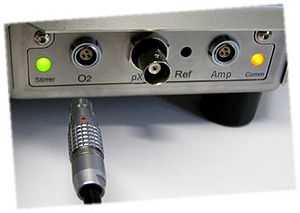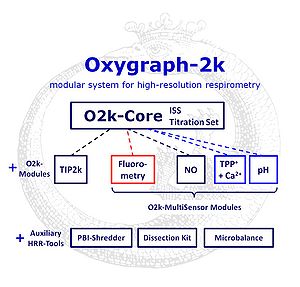Difference between revisions of "O2k signals and output"
(Blanked the page) |
|||
| Line 1: | Line 1: | ||
{{MitoPedia | |||
|description=Three electronic '''channel types''' are available in the [[O2k-MultiSensor |O2k-MultiSensor system]]. All channels are available twofold (dual-data), for O2k-Chambers A (left) and B (right), based on signals (numerical) sent at a fixed data sampling time interval (typical: 1 s or 2 s; range 0.2 s to >10 s). | |||
|info=[[O2k-Catalogue: O2k-MultiSensor]] | |||
}} | |||
{{MitoPedia concepts}} | |||
{{MitoPedia methods | |||
|mitopedia method=Respirometry, DatLab | |||
}} | |||
{{MitoPedia SUIT}} | |||
{{MitoPedia topics}} | |||
__TOC__ | |||
{{Template:Technical support integrated}} | |||
=== O2k signals === | |||
[[Image:O2k-Core plugs-for-modules.jpg|right|300px|O2k-Core.jpg]] | |||
: '''1. O<sub>2</sub> channel''' with electric current (ampere [Amp]) as the primary signal, which is converted to a voltage (volt [V]) as the raw signal. The [[O2k-Core]] supports not only the O<sub>2</sub> channel (O2 plug), but also the channel types 2 and 3 for the add-on modules. | |||
: '''2. Amp channel''': The amperometric channel of the O2k (Amp plug), has electric current (ampere [Amp]) as the primary signal, which is converted to a voltage (volt [V]) as the raw signal. The Amp channel is used with the [[O2k-Fluo LED2-Module]] and the [[O2k-NO Amp-Module]]. | |||
: '''3. pX channel''' with electric potential (volt [V]) as the primary and raw signal (BNC pX plug for the ion sensitive electrode, ISE; and separate plug for the pX reference electrode, Ref). | |||
'''NextGen-O2k''': additional channel types are available in the [[NextGen-O2k]]: | |||
: '''4. Dual-fluo channel'''. | |||
: '''5. Spectrophotometric channel'''. | |||
'''System channels''', for instrumental control, not separated into O2k-Chamber A and B (single-data), based on signals (numerical) sent at the same fixed data sampling time interval: | |||
: 6a. Block temperature: Measured block temperature equivalent to the experimental temperature in the O2k-Chambers at steady state [°C]. | |||
: 6b. Peltier power (system channel): Relative heating or cooling power of the Peltier system. | |||
: 6c. Barometric pressure (system channel): Measured barometric pressure [kPa]. | |||
: 6d. Ambient temperature (system channel): Measured temperature of room air (O2k-Series G upwards) [°C]. | |||
: 6e. External temperature (system channel): Temperature measured with an independently placed thermistor (O2k-Series G upwards) [°C]. | |||
'''[[Events]]''' carry information on a time point during the experiment, a short event name (text), and a longer string of comments (text): | |||
: 7. Events: Automatic events (e.g. from the [[TIP2k]]) and manually triggered events. | |||
=== O2k output === | |||
The 'output' of a channel is the finally important information, which may be summarized in a data base. | |||
'''Calibrated signals and derived plots''': Three types of output can be derived from the signal of the channels supported by the O2k-Core and displayed as separate plots: | |||
: '''I: Concentration'''. Examples: O<sub>2</sub>; Ca<sup>2+</sup>; [[concentration]] is amount of substance per volume [1 µM = 1 µmol·dm<sup>-3</sup> = 1 nmol·ml<sup>-1</sup>]. | |||
: '''II: Flow, flux, rate'''. Examples: O<sub>2</sub> consumption; H<sub>2</sub>O<sub>2</sub> production; volume-specific [[flux]] is the negative or positive time derivative of concentration over time, frequently multiplied by 1,000 [pmol·s<sup>-1</sup>·ml<sup>-1</sup>]. Volume-specific flux normalized for the cell density [10<sup>6</sup>·ml<sup>-1</sup>] is [[flow]] [pmol·s<sup>-1</sup>·ml<sup>-1</sup>]. Volume-specific flux normalized for the mass density of the sample in the O2k-Chamber [mg·ml<sup>-1</sup>] is mass-specific flux [pmol·s<sup>-1</sup>·mg<sup>-1</sup>]. Flux in any respiratory state normalized for flux in a defined reference state is a rate [dimensionless] or [[flux control ratio]]. | |||
: '''III: Force, potential'''. Examples: [[TMRM]] and [[Safranin]] for mt-membrane potential; redox potential from redox states of cytochromes or NADH . | |||
<br /> | |||
[[Image:Oxygraph-2k-Concept.jpg|right|300px|O2k-Concept.jpg]] | |||
'''Output types for the O2k-MultiSensor modules''' | |||
: 1. O<sub>2</sub> channel - [[O2k-Core]]: Output type I and II. | |||
: 2a. Amp channel - [[O2k-Fluo LED2-Module]]: The focus of the output depends on the specific fluorophore. Output type I, II, or III, or any combination may relate to the primary level of interest. | |||
: 2b. Amp channel - [[O2k-NO Amp-Module]]: Output type I and II. | |||
: 3a. pX channel - [[O2k-TPP+ ISE-Module]]: Output type III. | |||
: 3b. pX channel - [[O2k-pH ISE-Module]]: Output type I and II. | |||
'''Additional output types for the NextGen-O2k''' | |||
: 4. Single-fluo channel - [[NextGen-O2k]]: Plots of one selected wavelength can be selected for recording. Output type I(1), II(1), III(1) depends on the fluorophore. | |||
: 5. Dual-fluo channel - [[NextGen-O2k]]: Plots of two selected wavelengths can be selected for simultaneous recording. Output type I(2), II(2), III(2) depends on the fluorophore. | |||
: 6. Spectrophotometric channel - [[NextGen-O2k]]: Output type IV (three plots for redox states of cytochromes ''aa''<sub>3</sub>, ''b'', and ''c''). | |||
<br /> | |||
: '''V''': Pre-calibrated signals for system channels. | |||
<br /> | |||
: '''VI''': Events. | |||
Revision as of 08:42, 6 February 2016
Description
Three electronic channel types are available in the O2k-MultiSensor system. All channels are available twofold (dual-data), for O2k-Chambers A (left) and B (right), based on signals (numerical) sent at a fixed data sampling time interval (typical: 1 s or 2 s; range 0.2 s to >10 s).
Reference: O2k-Catalogue: O2k-MultiSensor
MitoPedia methods: Respirometry, "DatLab" is not in the list (Respirometry, Fluorometry, Spectrophotometry) of allowed values for the "MitoPedia method" property. DatLab
MitoPedia O2k and high-resolution respirometry:
O2k-Open Support
O2k signals
- 1. O2 channel with electric current (ampere [Amp]) as the primary signal, which is converted to a voltage (volt [V]) as the raw signal. The O2k-Core supports not only the O2 channel (O2 plug), but also the channel types 2 and 3 for the add-on modules.
- 2. Amp channel: The amperometric channel of the O2k (Amp plug), has electric current (ampere [Amp]) as the primary signal, which is converted to a voltage (volt [V]) as the raw signal. The Amp channel is used with the O2k-Fluo LED2-Module and the O2k-NO Amp-Module.
- 3. pX channel with electric potential (volt [V]) as the primary and raw signal (BNC pX plug for the ion sensitive electrode, ISE; and separate plug for the pX reference electrode, Ref).
NextGen-O2k: additional channel types are available in the NextGen-O2k:
- 4. Dual-fluo channel.
- 5. Spectrophotometric channel.
System channels, for instrumental control, not separated into O2k-Chamber A and B (single-data), based on signals (numerical) sent at the same fixed data sampling time interval:
- 6a. Block temperature: Measured block temperature equivalent to the experimental temperature in the O2k-Chambers at steady state [°C].
- 6b. Peltier power (system channel): Relative heating or cooling power of the Peltier system.
- 6c. Barometric pressure (system channel): Measured barometric pressure [kPa].
- 6d. Ambient temperature (system channel): Measured temperature of room air (O2k-Series G upwards) [°C].
- 6e. External temperature (system channel): Temperature measured with an independently placed thermistor (O2k-Series G upwards) [°C].
Events carry information on a time point during the experiment, a short event name (text), and a longer string of comments (text):
- 7. Events: Automatic events (e.g. from the TIP2k) and manually triggered events.
O2k output
The 'output' of a channel is the finally important information, which may be summarized in a data base.
Calibrated signals and derived plots: Three types of output can be derived from the signal of the channels supported by the O2k-Core and displayed as separate plots:
- I: Concentration. Examples: O2; Ca2+; concentration is amount of substance per volume [1 µM = 1 µmol·dm-3 = 1 nmol·ml-1].
- II: Flow, flux, rate. Examples: O2 consumption; H2O2 production; volume-specific flux is the negative or positive time derivative of concentration over time, frequently multiplied by 1,000 [pmol·s-1·ml-1]. Volume-specific flux normalized for the cell density [106·ml-1] is flow [pmol·s-1·ml-1]. Volume-specific flux normalized for the mass density of the sample in the O2k-Chamber [mg·ml-1] is mass-specific flux [pmol·s-1·mg-1]. Flux in any respiratory state normalized for flux in a defined reference state is a rate [dimensionless] or flux control ratio.
- III: Force, potential. Examples: TMRM and Safranin for mt-membrane potential; redox potential from redox states of cytochromes or NADH .
Output types for the O2k-MultiSensor modules
- 1. O2 channel - O2k-Core: Output type I and II.
- 2a. Amp channel - O2k-Fluo LED2-Module: The focus of the output depends on the specific fluorophore. Output type I, II, or III, or any combination may relate to the primary level of interest.
- 2b. Amp channel - O2k-NO Amp-Module: Output type I and II.
- 3a. pX channel - O2k-TPP+ ISE-Module: Output type III.
- 3b. pX channel - O2k-pH ISE-Module: Output type I and II.
Additional output types for the NextGen-O2k
- 4. Single-fluo channel - NextGen-O2k: Plots of one selected wavelength can be selected for recording. Output type I(1), II(1), III(1) depends on the fluorophore.
- 5. Dual-fluo channel - NextGen-O2k: Plots of two selected wavelengths can be selected for simultaneous recording. Output type I(2), II(2), III(2) depends on the fluorophore.
- 6. Spectrophotometric channel - NextGen-O2k: Output type IV (three plots for redox states of cytochromes aa3, b, and c).
- V: Pre-calibrated signals for system channels.
- VI: Events.



